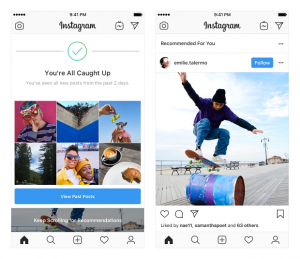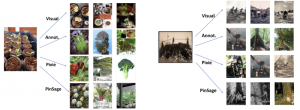Recently, Instagram has implemented a new way to discover posts, focusing on accounts similar to the ones already followed by its users. Like that, Pinterest implemented a new algorithm in the “share” tool that allows for better segmentation on recommended pins. Although the explanation given by Pinterest is quite technical, in reality the platform has succeeded on pushing engagement and the user’s time on the page, to understand how important this is we must remember that Pinterest is the primary platform for eCommerce and that it has the highest interest in purchase than any other social network, so it’s pretty obvious why they are trying to push engagement on the platform.
Instagram reDiscovery
Instagram said:
“You’ll see recommended posts at the end of your Feed, once you’ve seen everything new from people you follow. When you see the “Recommended For You” message, you’ll have the option to view your past posts or keep scrolling for your recommendations. And, if you’re interested in seeing more from the accounts shown in your recommended posts, just tap on the blue button to follow them.”
This seems like a bonus track for the message “You are all caught up” that came to fix Instagram last month. This will give them the opportunity to present options to the user that they would normally see on the “Explore” tab, all of this to accomplish a better use of the platform and avoid excessive use of data while scrolling through Instagram pointlessly.

Putting interest on Pinterest
Pinterest described a little about their objectives:
“The benefit of our approach is that by borrowing information from nearby nodes/Pins the resulting embedding of a node becomes more accurate and more robust. For example, a bed rail Pin might look like a garden fence, but gates and beds are rarely adjacent in the graph. Our model relies on this graph information to provide the context and allows us to disambiguate Pins that are (visually) similar, but semantically different”
Basically, what Pinterest is trying to accomplish is get as close as possible to the context of our “likes” than to the visuals, without really leaving them completely out either, remember that a big part of Pinterst’s success is “aesthetic”, namely the visual order of what we are looking at (things like coloc, theme and tone in your pins) to give the users what they really want to see, which is the whole point of recommendations: promote engagement through real interests.

Sources:
www.pinterest.com
www.instragarm.com
www.socialmediatoday.com

